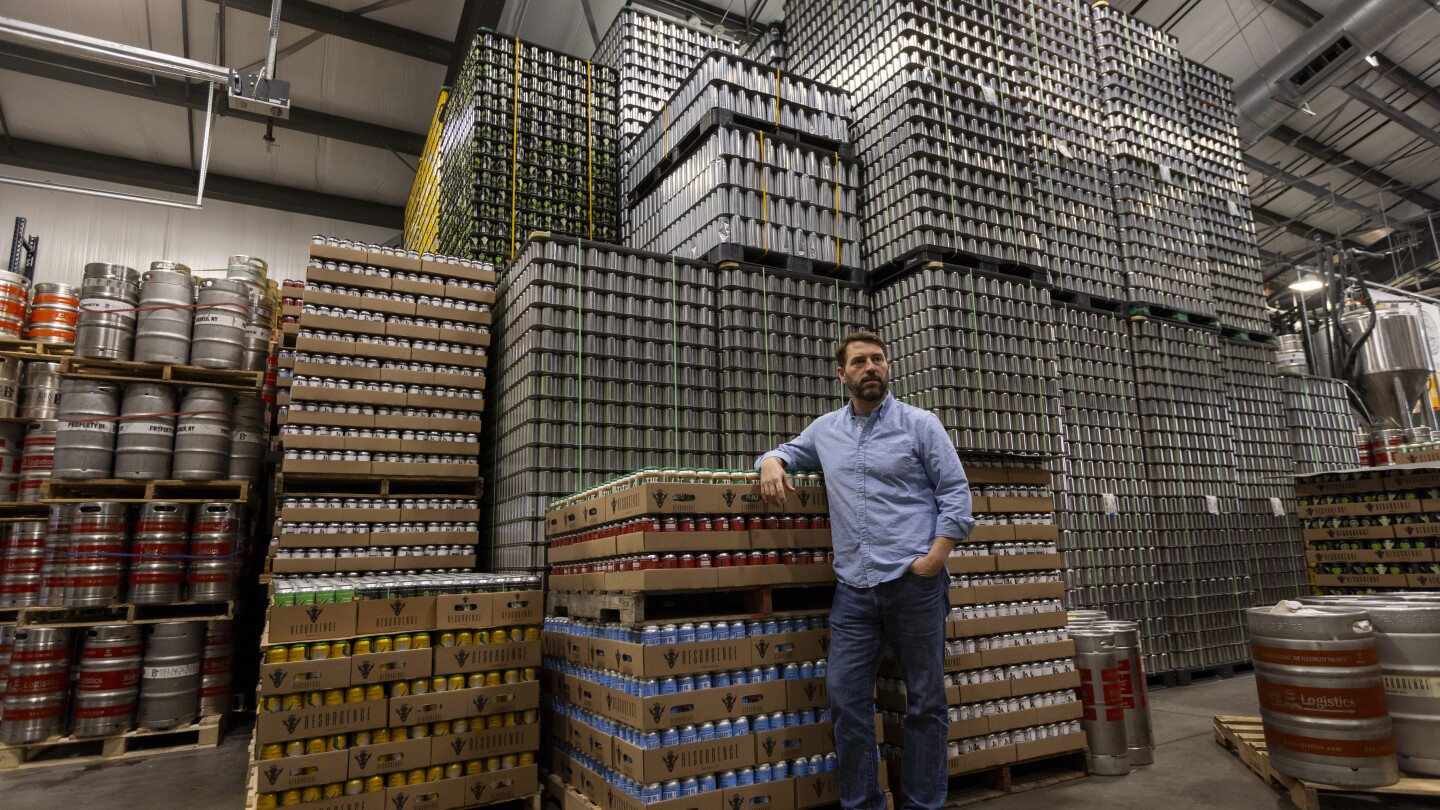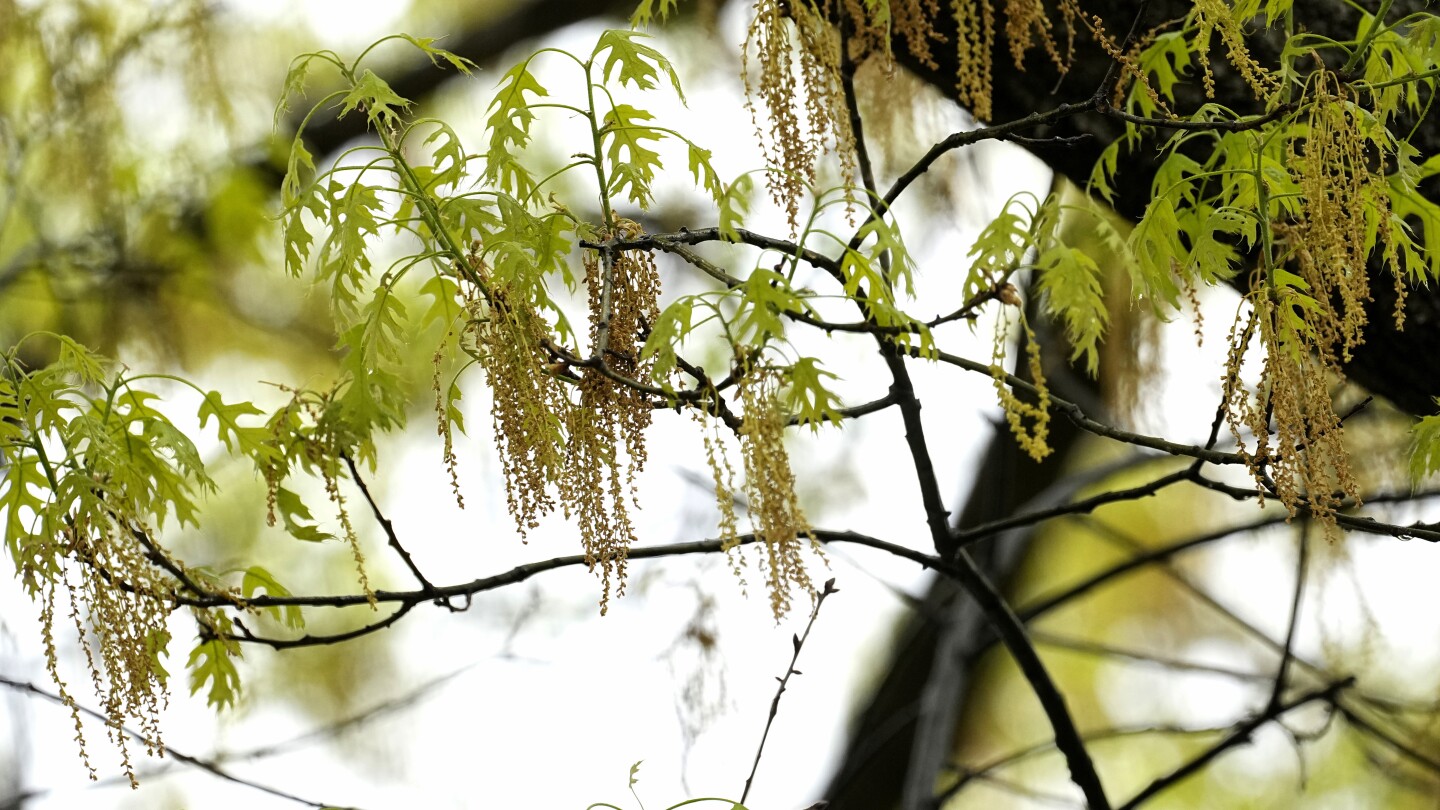Lifestyle
From soup cans to airplanes, steel and aluminum are a fundamental part of American life

Steel and aluminum are ubiquitous in Americans’ lives. A stainless steel refrigerator holds aluminum soda cans. A stainless steel drum tumbles inside an aluminum washing machine. They’re the metals used in cars and airplanes, phones and frying pans, skyscrapers and zippers.
That’s why President Donald Trump’s 25% tariffs on all steel and aluminum imports — which went into effect Wednesday — could have widespread impact on manufacturers and consumers.
Here are some of the industries and products that rely on aluminum and steel:
Construction
The construction industry uses about one-third of all U.S. steel shipments, more than any other industry, according to the Council on Foreign Relations. The industry depends on a global supply chain to build everything from airports to schools to roads, according to Associated Builders and Contractors, a trade group with more than 23,000 members.
The group says some contractors were able to lock in prices on steel or aluminum ahead of the tariffs. But if they are prolonged, the import taxes will ultimately raise prices at a time when the construction industry is already struggling with higher costs for labor and materials. And uncertainty around the tariffs will make it less likely that companies will commit to big building projects, the group said.
Annie Mecias-Murphy is the co-owner and president of JA&M, a contractor for commercial buildings based in Pembroke Pines, Florida. Some of the main materials her company uses are rebar, or reinforced steel, and post-tension cables, which reinforce concrete after it’s poured.
“In attempts to get ahead of the tariffs, we do try to lock in our prices and work with our trade partners and clients on different strategies,” Mecias-Murphy said. “But ultimately, the rising costs make it difficult for small business owners like myself to contemplate large-scale multi-year projects.”
Steel cans
Tin mill steel is used for a wide variety of packaging, from soup cans to hairspray. And the U.S. currently imports 70% of its tin mill steel, according to the Can Manufacturers Institute.
The institute said the more limited tariffs Trump imposed in 2018 resulted in the closure of nine tin mill lines in the U.S. as manufacturers shifted to other types of steel or simply shut down. As a result, only three U.S. tin steel lines remain open.
Mick Beekhuizen, the president and CEO of The Campbell Co., said in an earnings call last week that his company imports tin mill steel from Canada. Beekhuizen said Campbell is working with its suppliers to mitigate the impact of tariffs, but it may need to raise prices.
The Consumer Brands Association, which represents packaged food makers, said it’s urging the Trump administration to exempt aluminum and steel products that aren’t available in adequate quantities in the U.S. Otherwise, consumers will likely see higher grocery prices.
“We encourage the Trump administration to recognize the different needs of different U.S. manufacturing sectors,” said Tom Madrecki, vice president of supply chain resiliency at the Consumer Brands Association.
Autos
Most of Ford, GM and Stellantis’ steel and aluminum already comes from the United States, reducing the direct impact the companies would feel from higher duties.
But experts have warned that tariffs might mean the three Detroit automakers have to raise their prices. Domestic steel and aluminum producers will have to increase their capacity to meet demand or risk a short supply in the near term, making these products more expensive and driving up vehicle costs.
Another automaker who could feel the pain from tariffs: Elon Musk’s Tesla. During a January earnings call, Tesla Chief Financial Officer Vaibhav Taneja noted the uncertainty around tariffs.
“The imposition of tariffs, which is very likely, … will have an impact on our business and profitability,” Taneja said.
This could be detrimental to an already inflation-sensitive American car buyer. The average transaction price for a new vehicle was just over $48,000 last month, according to Kelley Blue Book.
And as with the steel and aluminum tariffs of Trump’s first term, automakers are likely to have to revisit their financial outlooks for the year as they brace for impact.
Appliances
Makers and sellers of products ranging from microwaves to dishwashers are considering how to navigate cost increases.
Some like Whirlpool, which produces 80% of what it sells in the U.S. domestically, appear to be more insulated from the tariffs. Whirlpool executives told analysts at an investor conference earlier this month that Whirlpool has locked in contracts for a minimum of one year for most of its raw materials, including steel.
But Abt, a family-owned appliance and consumer electronics store in Glenview, Illinois, received notices this week from manufacturers that said they would raise the suggested retail price of countertop products like espresso makers and toasters anywhere from 10% to 15% starting April 1, according to Richie Palmero, the store’s small appliance buyer.
Abt sells coffee makers that range from $100 to $500, as well as espresso makers priced from $1,000 to $5,000. Palmero said that putting another $250 on the price of a $2,500 espresso maker is a lot, but she said she doesn’t think sales will suffer significantly.
“I think customers would still buy it because it’s good quality,” she said. “But they might think about it. They might take longer to buy it. It might not be an impulse buy. I don’t think they’re going to go down to Mr. Coffee or a $20 coffee maker.”
Household goods
The Retail Industry Leaders Association said the compound effect of those import taxes, earlier tariffs on goods from China imposed during Trump’s first term and maintained by former President Joe Biden, and a new round slapped on Chinese products last month could be substantial.
The trade group, which represents major U.S. chains, asked its members to come up with a list of popular household items to illustrate how the multiple layers might add to the cost of finished products. The 20 entries included pushpins, trash cans, ladders, grills, paper towel holders, mixing bowls, wine racks, shower caddies, chicken coops and steel wool.
By the association’s calculations, the selected imports face a potential duty of 45% to over 70% when they go through U.S. customs. The amounts varied depending on where the products were made and if they already were subject to a base tax or a tariff from Trump’s first term. Portable griddles and tabletop grills from China, which had the highest starting duty, would get taxed at almost 75% of its value.
“Stacking tariffs on household goods will also raise costs on American families, millions of whom have struggled through the worst bout of inflation in 40 years,” Michael Hanson, a senior executive vice president at the Retail Leaders Industry Association, said in a Wednesday statement.
Aluminum cans
U.S. beverage companies use more than 100 billion aluminum cans each year, according to the Can Manufacturers Institute. Most of the thin rolled sheets of aluminum alloy that are used for cans are made in the U.S., but can makers do import a small percentage, the institute said.
The Brewers Association, which represents 9,500 independent U.S. craft beer makers, estimates that 10% of U.S. cans are made from Canadian aluminum. Aluminum tariffs will force small brewers to pay more for cans, the association said, even as steel tariffs drive up the cost of equipment like kegs and fermentation tanks.
But not all manufacturers are worried about aluminum tariffs. Molson Coors says it shifted production in recent years and now gets “almost all” of its aluminum for U.S. consumption from U.S. sources.
Coca-Cola Chairman and CEO James Quincey said during a recent earnings call that if aluminum cans get more expensive, Coke can shift to other materials like plastic bottles. Quincey told investors he didn’t want to exaggerate the cost of aluminum tariffs.
“You should not conclude that this is some huge swing factor in the U.S. business,” he said. “It’s a cost. It will have to be managed. It would be better not to have it relative to the U.S. business, but we are going to manage our way through.”
Aviation
Airplanes have a mixture of metal parts, from aluminum frames, wings and door panels to steel landing gear and engine parts. Many are extremely specialized and sourced from overseas.
The Aerospace Industries Association, which represents nearly 300 aerospace and defense companies, says tariffs put their industry — and national security — at risk.
“We are concerned about additional downward pressure on an already stressed American supply chain,” Dak Hardwick, the association’s vice president of international affairs, said. “We are investigating mitigation strategies that would minimize the impacts of new tariffs on our industry, and we hope to work with the Trump Administration to highlight the critical role we play in America’s economic prosperity, national defense and deterrence.”
___
AP Climate reporter Alexa St. John in Detroit contributed reporting.
Lifestyle
Allergy season: How to check pollen levels and alleviate symptoms

ATLANTA (AP) — Allergy season can be miserable for tens of millions of Americans when trees, grass, and other pollens cause runny noses, itchy eyes, coughing and sneezing.
Where you live, what you’re allergic to and your lifestyle can make a big difference when it comes to the severity of your allergies. Experts say climate change is leading to longer and more intense allergy seasons, but also point out that treatments for seasonal allergies have become more effective over the last decade.
Here are some tips from experts to keep allergy symptoms at bay — maybe even enough to allow you to enjoy the outdoors.
Where are pollen levels the worst this year?
The Asthma and Allergy Foundation of America issues an annual ranking of the most challenging cities to live in if you have allergies, based on over-the-counter medicine use, pollen counts and the number of available allergy specialists.
This year, the top five cities are: Wichita, Kansas; New Orleans; Oklahoma City; Tulsa, Oklahoma; and Memphis.
Which pollens cause allergies?
There are three main types of pollen. Earlier in the spring, tree pollen is the main culprit. After that grasses pollinate, followed by weeds in the late summer and early fall.
Some of the most common tree pollens that cause allergies include birch, cedar, cottonwood, maple, elm, oak and walnut, according to the Asthma and Allergy Foundation of America. Grasses that cause symptoms include Bermuda, Johnson, rye and Kentucky bluegrass.
This article is part of AP’s Be Well coverage, focusing on wellness, fitness, diet and mental health. Read more Be Well.
How do I track pollen levels?
Pollen trackers can help you decide when to go outside. The American Academy of Allergy Asthma and Immunology tracks levels through a network of counting stations across the U.S. Counts are available at its website and via email.
Limit your exposure to pollens
The best and first step to controlling allergies is avoiding exposure. Keep the windows in your car and your home closed, even when it’s nice outside.
If you go outside, wearing long sleeves can keep pollen off your skin to help ward off allergic reactions, said Dr. James Baker, an allergist at the University of Michigan. It also provides some sun protection, he added.
When you get home, change your clothes and shower daily to ensure all the pollen is off of you — including your hair. If you can’t wash your hair every day, try covering it when you go outside with a hat or scarf. Don’t get in the bed with your outside clothes on, because the pollen will follow.
It’s also useful to rinse your eyes and nose with saline to remove any pollen, experts said. And the same masks that got us through the pandemic can protect you from allergies — though they won’t help with eye symptoms.
How to relieve allergy symptoms
Over-the-counter nasal sprays are among the most effective treatments for seasonal allergies, experts said.
But the vast majority of patients use them incorrectly, irritating parts of the nose, said Dr. Kathleen Mays, an allergist at Augusta University in Georgia. She suggested angling the nozzle outward toward your ear rather than sticking it straight up your nose.
Over-the-counter allergy pills like Claritin, Allegra and Zyrtec are helpful, but may not be as effective as quickly since they’re taken by mouth, experts said.
Experts also said that if your allergy symptoms are impacting your quality of life, like causing you to lose sleep or a lack focus at work or school, it might be time to consider an allergist appointment for immunotherapies.
Some remedies for allergy relief that have been circulating on social media or suggested by celebrities — like incorporating local honey into your diet to expose yourself to pollen — have been debunked.
Dr. Shayam Joshi, an allergist at Oregon Health and Science University, said that’s because the flowers that bees pollinate typically don’t contain the airborne pollen that causes allergy symptoms.
Is allergy season changing?
With climate change, winters are milder and growing seasons are longer, meaning there’s more opportunity for pollen to stay in the air, resulting in longer and more severe allergy seasons.
In many areas across the country, pollen counts have broken decades of records. In late March, the Atlanta Allergy and Asthma Center measured a pollen count of over 14,000 grains per cubic meter, which is considered extremely high.
___
The Associated Press Health and Science Department receives support from the Howard Hughes Medical Institute’s Science and Educational Media Group and the Robert Wood Johnson Foundation. The AP is solely responsible for all content.
Lifestyle
The 250th anniversary of the Battles of Lexington and Concord opens debate over US independence
NEW YORK (AP) — The American Revolution began 250 years ago, in a blast of gunshot and a trail of colonial spin.
Starting with Saturday’s anniversary of the Battles of Lexington and Concord, the country will look back to its war of independence and ask where its legacy stands today.
The semiquincentennial comes as President Donald Trump, the scholarly community and others divide over whether to have a yearlong party leading up to July 4, 2026, as Trump has called for, or to balance any celebrations with questions about women, the enslaved and Indigenous people and what their stories reveal.
The history of Lexington and Concord in Massachusetts is half-known, the myth deeply rooted.
What exactly happened at Lexington and Concord?
Reenactors may with confidence tell us that hundreds of British troops marched from Boston in the early morning of April 19, 1775, and gathered about 14 miles (22.5 kilometers) northwest on Lexington’s town green.
Firsthand witnesses remembered some British officers yelled, “Thrown down your arms, ye villains, ye rebels!” and that amid the chaos a shot was heard, followed by “scattered fire” from the British. The battle turned so fierce that the area reeked of burning powder. By day’s end, the fighting had continued around 7 miles (11 kilometers) west to Concord and some 250 British and 95 colonists were killed or wounded.
But no one has learned who fired first, or why. And the revolution itself was initially less a revolution than a demand for better terms.
Woody Holton, a professor of early American history at the University of South Carolina, says most scholars agree the rebels of April 1775 weren’t looking to leave the empire, but to repair their relationship with King George III and go back to the days preceding the Stamp Act, the Tea Act and other disputes of the previous decade.
“The colonists only wanted to turn back the clock to 1763,” he said.
Stacy Schiff, a Pulitzer Prize winning historian whose books include biographies of Benjamin Franklin and Samuel Adams, said Lexington and Concord “galvanized opinion precisely as the Massachusetts men hoped it would, though still it would be a long road to a vote for independence, which Adams felt should have been declared on 20 April 1775.”
But at the time, Schiff added, “It did not seem possible that a mother country and her colony had actually come to blows.”
A fight for the ages
The rebels had already believed their cause greater than a disagreement between subjects and rulers. Well before the turning points of 1776, before the Declaration of Independence or Thomas Paine’s boast that “We have it in our power to begin the world over again,” they cast themselves in a drama for the ages.
The so-called Suffolk Resolves of 1774, drafted by civic leaders of Suffolk County, Massachusetts, prayed for a life “unfettered by power, unclogged with shackles,” a fight that would determine the “fate of this new world, and of unborn millions.”
The revolution was an ongoing story of surprise and improvisation. Military historian Rick Atkinson, whose “The Fate of the Day” is the second of a planned trilogy on the war, called Lexington and Concord “a clear win for the home team,” if only because the British hadn’t expected such impassioned resistance from the colony’s militia.
The British, ever underestimating those whom King George regarded as a “deluded and unhappy multitude,” would be knocked back again when the rebels promptly framed and transmitted a narrative blaming the royal forces.
“Once shots were fired in Lexington, Samuel Adams and Joseph Warren did all in their power to collect statements from witnesses and to circulate them quickly; it was essential that the colonies, and the world, understand who had fired first,” Schiff said. “Adams was convinced that the Lexington skirmish would be ‘famed in the history of this country.’ He knocked himself out to make clear who the aggressors had been.”
A country still in progress
Neither side imagined a war lasting eight years, or had confidence in what kind of country would be born out of it. The founders united in their quest for self-government but differed how to actually govern, and whether self-government could even last.
Americans have never stopped debating the balance of powers, the rules of enfranchisement or how widely to apply the exhortation, “All men are created equal.”
“I think it’s important to remember that the language of the founders was aspirational. The idea that it was self-evident all men were created equal was preposterous at a time when hundreds of thousands were enslaved,” said Atkinson, who cites the 20th-century poet Archibald MacLeish’s contention that “democracy is never a thing done.”
“I don’t think the founders had any sense of a country that some day would have 330 million people,” Atkinson said. “Our country is an unfinished project and likely always will be.”
Lifestyle
Sweets from the sky! A helicopter marshmallow drop thrills kids in suburban Detroit

ROYAL OAK, Mich. (AP) — It’s spring in Detroit — warm weather, a few clouds, and a 100% chance of marshmallow downpours.
The source? A helicopter zooming above the green lawn of Worden Park on Friday, unloading sack-fulls of fluffy treats for hundreds of kids waiting eagerly below, some clutching colorful baskets or wearing rabbit ears.
The children cheered and pointed as the helicopter clattered by on its way to the drop zone. Volunteers in yellow vests made sure kids didn’t rush in and start grabbing marshmallows until after the deluge was complete.
For anyone worried about hygiene, don’t fret. The annual Great Marshmallow Drop isn’t about eating the marshmallows — kids could exchange them for a prize bag that included a water park pass and a kite.
The marshmallow drop has been held for over three decades in the Detroit suburb of Royal Oak, Michigan, hosted by Oakland County Parks.
One toddler, Georgia Mason, had no difficulty procuring a marshmallow at her first drop, her dad Matt said.
“Probably the most exciting part was seeing the helicopters. But once we saw the marshmallows drop, we got really excited,” Matt Mason said.
“And, yeah, we joined the melee,” he said, “We managed to get one pretty easy.”
Organizers said 15,000 marshmallows were dropped in all.
The helicopter made four passes, dropping marshmallows for kids in three age categories: 4-year-olds and younger, 5-7-year-olds, and those ages 8 to 12. A drop for kids of all ages with disabilities came later in the day.
“We do it because it’s great for community engagement,” Oakland County recreation program supervisor Melissa Nawrocki said.
“The kids love it,” she continued. “The looks on their faces as they’re picking up their marshmallow and turning in the marshmallow for prizes is great.”
-

 Education1 day ago
Education1 day agoHarvard’s battle with the Trump administration is creating a thorny financial situation
-

 Lifestyle1 day ago
Lifestyle1 day agoSweets from the sky! A helicopter marshmallow drop thrills kids in suburban Detroit
-

 Sports1 day ago
Sports1 day agoAaron Rodgers ‘not holding anybody hostage’ as he decides his future, retirement a possibility
-

 Conflict Zones1 day ago
Conflict Zones1 day agoTrump says US may ‘pass’ on helping end war if Russia, Ukraine resist deal | Russia-Ukraine war News
-

 Sports2 days ago
Sports2 days agoNY Rangers’ Panarin, MSG reportedly made settlement payments after employee made sexual assault allegations
-

 Europe2 days ago
Europe2 days agoLive updates: Trump news, Ukraine peace talks, US immigration, tariffs and university funding
-

 Lifestyle1 day ago
Lifestyle1 day agoFans of Superman relate to comic’s religious and ethical themes
-

 Europe1 day ago
Europe1 day agoTrump’s ‘lone ranger’: How Steve Witkoff became the defacto point man on America’s foreign policy challenges



